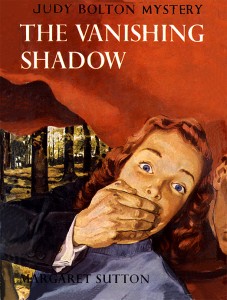
Nancy Drew, a familiar name even to those who have never opened a juvenile mystery. The original books have been edited, altered, modernized and celebrated in film and TV. Even today there are contemporary stories featuring the teenager and her two girl friends, Bess and George. But if you are like most, you’ve never heard of Nancy’s rival, Judy Bolton. Unlike Nancy, Judy has been forgotten except by her rabid fans and collectors of juvenile books. And that’s unfortunate. Because Judy, in practically every way, is a superior character and girl sleuth among contemporaries in the 1930s and beyond.
Judy’s first adventure followed on the heels of Nancy’s debut. In 1932 Grosset and Dunlap published The Vanishing Shadow, the first of 38 titles. Unlike Nancy, however, Judy 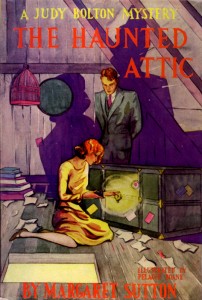 was not the brainchild of Edward Stratemeyer, the person behind the Hardy Boy series, whose idea for a girl sleuth brought about Nancy. Nor was the author hired to flesh out a story idea, as Mildred Wirt was for the Drew series. Margaret Sutton created her own character, and wrote every entry in the long series. Wirt began the Drew series, and various others took up the task all under the pseudonym Carolyn Keene. And that’s just the start of the many differences between the two series and perhaps the most important. When a character is the amalgamation of various voices, it loses its uniqueness.
was not the brainchild of Edward Stratemeyer, the person behind the Hardy Boy series, whose idea for a girl sleuth brought about Nancy. Nor was the author hired to flesh out a story idea, as Mildred Wirt was for the Drew series. Margaret Sutton created her own character, and wrote every entry in the long series. Wirt began the Drew series, and various others took up the task all under the pseudonym Carolyn Keene. And that’s just the start of the many differences between the two series and perhaps the most important. When a character is the amalgamation of various voices, it loses its uniqueness.
Margaret Sutton, a high school dropout from the middle of Pennsylvania, began a career, not something easy for a woman at that time, after attending Rochester Business Institute in 1920. Marrying William H. Sutton, provided her last name, and the publisher dubbed her Margaret, rather than using her real one, Rachel Irene. As Margaret Sutton, she skillfully wove real experiences and events from her hometown and life into Judy’s fictional world. This technique is another large contrast to the Drew series, where the town, people, and events were entirely arbitrary. Judy is a well-rounded character with faults, including a temper. A redhead who is “attracted to any kind of excitement as a needle to a magnet” Judy’s an all-American girl, independent and headstrong. Although in the early novels Nancy exhibited the same characteristics, after the brutal editing and revamping of the series by the original publisher’s daughter, Nancy became a lifeless perfect person. Judy, on the other hand, not only matured as a character, she physically grew up in the stories. Going from very young teen, to mature married woman. Her sensibilities altered as well. Judy’s childish understanding of the world evolved as she learned some profound life lessons, taught in each series entry.
Growing up, as opposed to remaining 16 or 18 forever, like Nancy, afforded Judy more mature subject matter. Right out of the box, Sutton made it clear her setting and characters would face great challenges and even real violence, unheard of in the Drew series which the worst that may happen to any of the characters was being caught by the villains and detained. People die, just like real life. In The Vanishing Shadow, we are introduced to Judy, her doctor father, homemaker mother, and timid brother, Horace. Being a doctor in 1930s did not make you a grand salary; therefore Judy was not of the upper crust. They 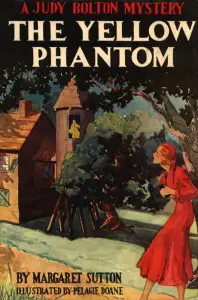 lived a modest comfortable life of the newly created middle class. Judy’s grandparents owned a farm. Their little town, Roulsville, sat in a narrow valley between a small stream, and larger body of water. Judy had watched with interest the construction of a new dam, and ‘new concrete road.” While solitarily reading under a large shade tree to beat the heat of summer, she overheard a couple of construction workers make some inferences to the newly built dam, as they bullied a fellow worker to ‘better keep his mouth shut ”. Thus began a series that lasted until 1967.
lived a modest comfortable life of the newly created middle class. Judy’s grandparents owned a farm. Their little town, Roulsville, sat in a narrow valley between a small stream, and larger body of water. Judy had watched with interest the construction of a new dam, and ‘new concrete road.” While solitarily reading under a large shade tree to beat the heat of summer, she overheard a couple of construction workers make some inferences to the newly built dam, as they bullied a fellow worker to ‘better keep his mouth shut ”. Thus began a series that lasted until 1967.
Within a couple of chapters of the first book exciting things happen. “A hand was clapped across Judy’s mouth with such violence that she staggered backward and caught her breath in
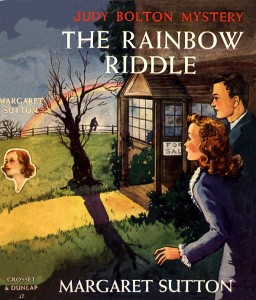
a quick terrified gasp”. She was held overnight in a swamp, later tied up, and thrown into a car. Although brave enough, Judy wasn’t a fool or superhero. When finally dumped, wrapped in a big bag, she was shaken, and questioned not only her valor, but also her thinking. Nancy would have done neither.
The art on the 40s or 50s dust jacket depicts a close-up of a startled Judy, with a man’s arm firmly over her mouth, and is indicative of how Ms. Sutton wrote her stories. Even today(!), the jacket can be ‘too disturbing’ for at least one mother. I gave a vintage copy of the book with jacket to a niece when she was around 11 or 12, and the mother looked as though I’d just handed her porn. I knew the book would be discarded the moment I wasn’t present. On the other niece, lol, at 10, I handed her the same title with jacket, and not a flicker of concern passed mother or daughter’s face. This niece loved it.
Judy didn’t have a Ned in the background for exploiting when needed, as Nancy kept her male pal. Judy had two, yes two, viable handsome boyfriends. Rich Arthur Farringdon-Pett is an engineer, who named his sedan Bluebird, and flies his own plane. When we first meet Peter Dobbs, Judy’s other beau, he’s studying at college and lives with his grandparents, his grandfather making the mistake of selling his interest in the town’s industry, the paper mill. Peter later becomes a lawyer who then evolves into an FBI agent. Each is older by a few years. Also, Judy doesn’t limit herself with only two close girlfriends like Nancy’s posse, George and Bess, she collects them throughout her life. And, they don’t all belong to her social class. Some are richer, some poorer. Some are real bitches to begin with. Some have questionable morals. Some are sweet as candy. All turn out to be swell through Judy’s influence and sleuthing.
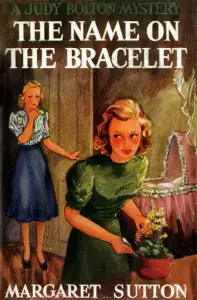
The upper crust girls are snobs to Judy and the lower class ones, in a mystery following close behind the first. Another title deals with missing siblings. There is social commentary in a soft manner dealing with labor issues, class differences, adoption, abducted children, switched at birth babies, and later on, the evils of communism. Judy reflected current events that the Nancy Drew novels didn’t bother with. Trivial things such as poverty or changing political atmospheres were nonexistent so long as Nancy had her roadster, perky blonde hair (later titian), and lawyer father. The early publications before the cleansing, were rife with racism, anti-Semitism, and other norms of the times. And a spunkier more independent Nancy. And a very rich Nancy who was unaffected by the Great Depression, WWII, just plain life. Although her character was a bit more fleshed out than in later editions, Nancy nonetheless seems to be a girl who never does a day’s work in her life, lives off of her dad, and detects, looking for jewels and wills, and the occasional conveyancing of property, whereas Judy tends to be assisting a friend in some way during her sleuthing. Some may argue that once the offending material was removed, the Drew books have a more universal appeal because they’re not set in a particular time and place. Perhaps so. But with no historical context, you have cardboard characters and unrealistic situations. Not lively moving plots with suspense and depth.
Each book in the Judy Bolton series has some foundation in Ms. Sutton’s real life experiences growing up. The biggest event – a flood wiping out her entire town, one that was used to perfection in her first book. After the flood, Life is altered for all who lived there. Some move to the nearby Farringdon. Judy’s family takes an offer to live in a ‘haunted’ house rent free in town, thereby setting up the next exciting chapter in Judy’s life.
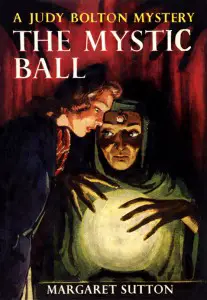
As each book is read, Judy matures, chooses a mate, and changes with the times. By 1967 Margaret Sutton has stated that The Stratemeyer Syndicate saw Judy as a threat to their big money maker, Nancy Drew, so decided to pull the plug on the series. Judy had a long quality run under one guiding hand. And here’s where I become puzzled. Whenever I mention 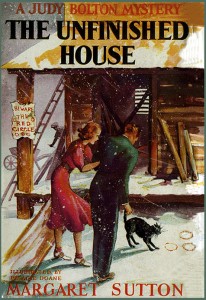 the series to a comtemporary, no one remembers reading the books. My mother handed Nancy Drew and Judy Bolton books down to me, and I sent them off to cousins when I’d out gown them. Wasn’t Judy given to other girls my age? The books must have sold decently to be published for so long. Why girls my age didn’t read Bolton is strange to me. When the books stopped being written and published, I understand why they disappeared from the public eye. While Nancy Drew has been reprinted and reborn in each decade, Judy faded from sight.
the series to a comtemporary, no one remembers reading the books. My mother handed Nancy Drew and Judy Bolton books down to me, and I sent them off to cousins when I’d out gown them. Wasn’t Judy given to other girls my age? The books must have sold decently to be published for so long. Why girls my age didn’t read Bolton is strange to me. When the books stopped being written and published, I understand why they disappeared from the public eye. While Nancy Drew has been reprinted and reborn in each decade, Judy faded from sight.
A few years back we were at a favorite used bookstore in Bordentown, NJ, The Old Bookshop, and sitting in several boxes was almost the entire set of Judy Boltons—most in jacket—not 30s, jackets, but 40s which is a novelty too. I wanted to re-read them to find out if I was exaggerating the quality and importance of the series in my own head. My sweet husband made an offer, it was accepted and I began my journey anew, in Margaret Sutton’s imagination. It hasn’t disappointed, quite the contrary. They are just as readable and enjoyable when read as an adult. Perhaps a teeny bit more because we now have life’s experience to see underneath the girl sleuth’s actions and to appreciate her uniqueness, bravery, and outstanding early role model for young girls. To me, the most telling and important of the differences between Judy and Nancy—Judy is now an adult, like real girls become, suffering through loss, happy events, and just plain life. Nancy will always be stuck at 18, in her privileged world with perfect features, perfect hair, perfect cars, perfect friends and boring one-dimensional world.

A fun footnote ( at least for me)–caution–spoiler for The Voice in the Suitcase. Turns out, the ‘voice’ was a ferret!!! Naturally, it became one of my favorite Judy Bolton books immediately.

Finally! FINALLY someone is giving respect to Judy! My copies were passed to me from a friend of my parents and eventually were read to pieces by me and my fellow Rainbow Girls. Finding “new” copies meant lucking into one or two of them at a church rummage sale or massive spring cleaning by someone on the block who hated yard sales.
I knew there was a reason I liked you, lol! The interesting thing for me as an adult, I could remember just one Nancy Drew–The Tolling Bells–and when I reread it, I couldn’t find anything all that great. I don’t think it was written by Wirt, but when I reread the Old Clock–that didn’t do anything for me either. But I remembered many things about Judy, two boyfriends, one rich, (whom I sort of wanted her to marry–I must have been a gold digger young girl), the flood, the town, her parents, the friends from the wrong side of the tracks, and in particular–The Mystic Ball. The dust jacket art on the later printing is scrumptious, and I loved the idea of a mystic telling the future–still do, lol.
LOL! Birds of a feather… I may hunt them down at some point to revisit them. Did I ever finish a Nancy Drew book? Maybe for a friend’s attempt at a book club one summer, but I’m not even sure which one it was.
Last month I attended the annual Judy Bolton Days in Coudersport PA where the series is set, visiting the actual sites from the series including exploring the dam. Icowro
As a long time Judy Bolton fan, I would agree with you.
What a great article!!